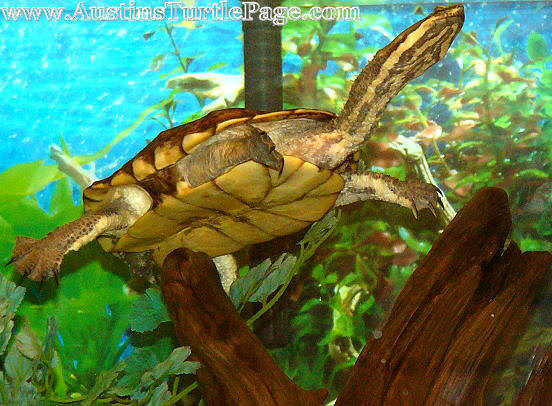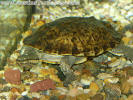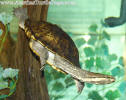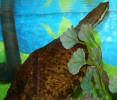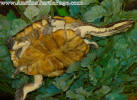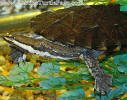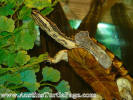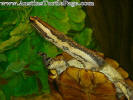|
|
|
|
|
Carapace - Their oval, dark-brown (sometimes speckled) carapace has nearly equal sides and is relatively flattened. The surface of their carapace can be either smooth or boast a series of thorn-like or cone-like knobs on the scutes going down the center of the back, forming a ridge down the middle (the carapace becomes smooth as they mature). These knobs are also present on the scutes on both sides of the middle ridge and are sometimes maintained in old adults. The narrow bridge can range from brown or yellow with large brown blotches. Plastron - The plastron's color and pattern is variable, ranging from an immaculate yellow to yellow with brown blotches. There are some individuals who sport a black pattern. Males have a concave plastron with deep anal notches. Head - The head of Hydromedusa tectifera is moderately sized with a short, slightly protruding snout and an upper jaw that does not have a notch and it is not hooked. The top of the head is covered with numerous, irregularly shaped scales. The head can be olive to gray with a broad, black-bordered white or cream colored stripe extending from the upper jaw back along the neck. The jaws themsevles can be either yellow or tan in color. The underside of the head and the chin are yellow with dark spots or lines through the length of their neck and contains numerous "spikes" along the sides. Size - Males can reach 7 - 9" whereas females can grow to be 10 - 12".longer, thicker tail with the vent beyond the rim of the carapace. Additional: The front of the front legs and the back of the back legs have large, transverse scales. There are a total of 4 claws per foot. Their tails are olive gray. |
||
|
|
|
|
|
|
|
|
Their range is from the states of Sao Paulo and Rio Grande do
Sul in southeastern Brazil westward and southward through the eastern Paraguay
and the Chaco and northeastern Argentina to Uruguay.
|
||
|
|
|
|
|
|
|
|||||
TEMPERATURE RANGE (°F)
Even though this species originates in the hot, humid climates, they do not handle extreme heat very well. They are surprisingly tolerant to cold weather, although keeping them outside year round in northern climates in not recommended. They inhabit waters rich in vegetation and shade which aids in keeping the water cool.
Argentine Snakenecks are difficult turtles to keep based on both their finicky appetites and feeding as well as their water quality needs. CAPTIVE DIET These turtles are strict carnivores. In captivity, these turtles accept a wide variety of live foods (fish, worms, crickets, pinkie mice, snails) as well as sliced meats like chicken and fish as well as beefheart. When accepted, a prepared turtle food, such as Muzari, ReptoMin or ZooMed is recommended to augment their natural diet.
RECOMMENDED FEEDING SCHEDULE As with most turtles, this species is always willing and ready to receive a meal. Keep in mind that keeping fish in the habitat on a regular basis will ensure that they are not going hungry. In the wild they do not feed daily and are able to go several weeks without food. I recommend feeding these turtles only once per week once they have reached 2 years in age, again, ensuring that there are feeder fish in the habitat for them to snack on and to hunt.. CAPTIVE HABITAT A secretive species, Argentine Snakenecks enjoy hiding. Underwater hiding spots and lots of vegetation/water plants are highly recommended and in some individuals, required for good health (stress). They are infrequent baskers, but do come out to bask usually in the early mornings or late evenings. A soft substrate is recommended as these turtles are prone to shell injuries from habitat decorations. High water quality is a must as these turtles are also highly susceptible to fungal outbreaks. This species requires a very low pH, consisting of the range between 5.0 and 5.8 for best keeping. RECOMMENDED ENCLOSURE It is recommended that adults and sub-adults be kept in nothing smaller than a 90 gallon tank for males and 125 gallon tank for females. Adding more individuals would obviously require additional space. They are fairly active turtles, but fortunately do not require an exorbitant amount of room. A basking area with smooth access is required as well as the addition of a strong UVB light and basking/heat lamp. A secretive species, it is beneficial to the turtles to have an abundance of vegetation for them to peruse through and hide in. WATER DEPTH Argentine Snakenecks are accomplished swimmers, even as fresh hatchlings, and enjoy deep water. COMMUNITY HABITAT Argentine Snakenecks are acceptable species for community set ups, however, due to their preference to water with a low pH, they are often housed by themselves. Podocnemis spp have successfully been housed with Hydromedusas without problems. |
|||||||
|
|
|
|
|
|
|
| Hydromedusa may lay anywhere from 4 to 14 eggs. | ||
|
|
|
|
|
|
|
|
ENCLOSURE Excellent swimmers when first born, these babies do extremely well in deep water habitats with low current. It is highly recommended to add numerous aquatic plants to allow for hiding. Powerful filtration is required as hatchlings are susceptible to shell infections and poor water quality. DIET Earthworms, tadpoles, small fish, aquatic insects, snails and larval mosquitos make up the majority of a young tectifera's diet. This should be augmented with a high quality prepared food such as Mazuri, ReptoMin or ZooMed, provided that they can be coaxed to take pelleted foods. |
||
|
|
|
